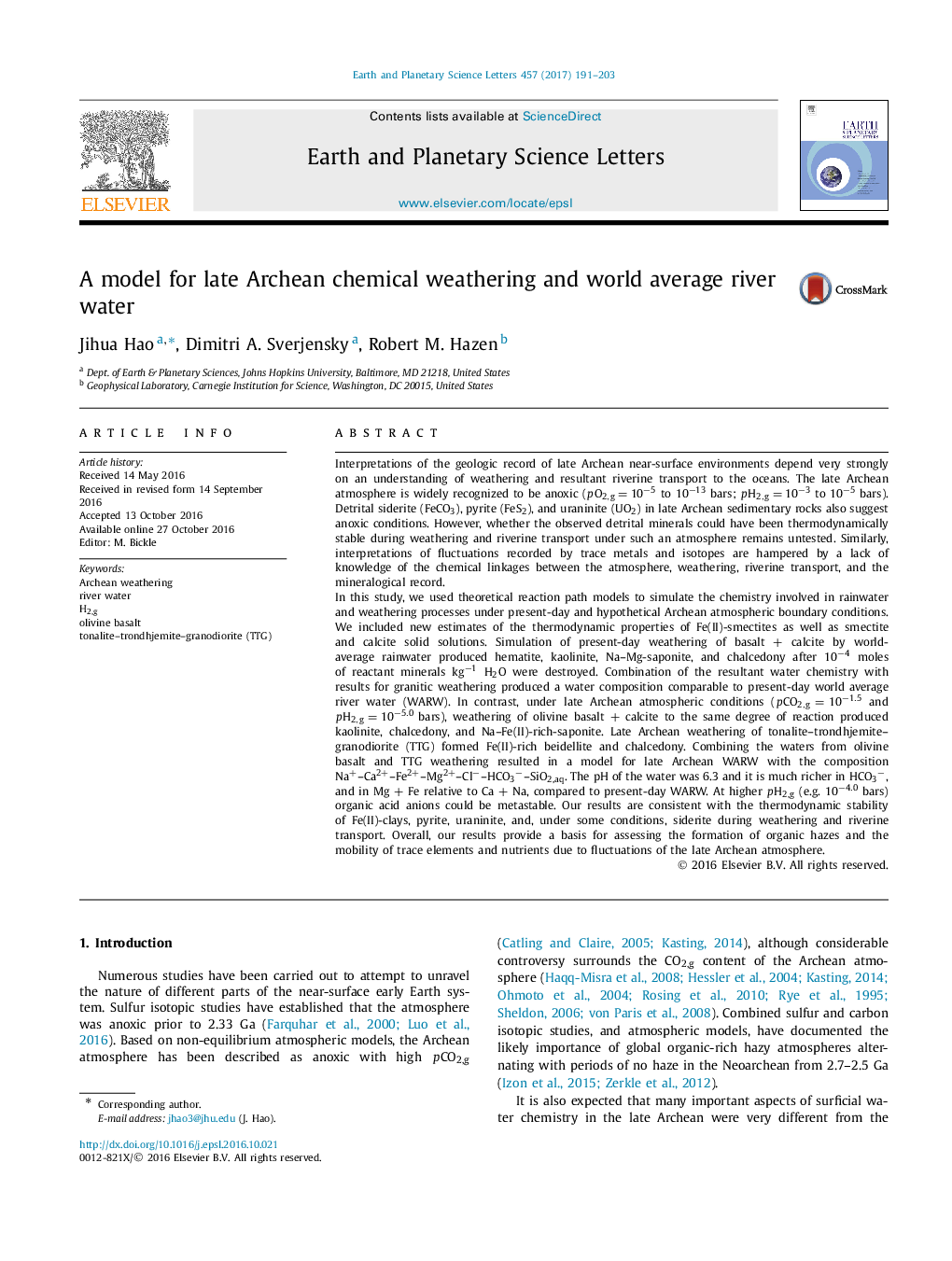| کد مقاله | کد نشریه | سال انتشار | مقاله انگلیسی | نسخه تمام متن |
|---|---|---|---|---|
| 5780059 | 1634699 | 2017 | 13 صفحه PDF | دانلود رایگان |
- Model of present-day and late Archean weathering and world-average river water.
- Late Archean weathering formed Fe(II)-rich carbonate and clay minerals.
- Detrital pyrite, siderite, and uraninite stable during late Archean weathering.
- Late Archean riverwater had high Fe(II) and C, and low S and pH.
- Archean weathering environment may contribute to haze formation.
Interpretations of the geologic record of late Archean near-surface environments depend very strongly on an understanding of weathering and resultant riverine transport to the oceans. The late Archean atmosphere is widely recognized to be anoxic (pO2,g=10â5 to 10â13Â bars; pH2,g=10â3 to 10â5Â bars). Detrital siderite (FeCO3), pyrite (FeS2), and uraninite (UO2) in late Archean sedimentary rocks also suggest anoxic conditions. However, whether the observed detrital minerals could have been thermodynamically stable during weathering and riverine transport under such an atmosphere remains untested. Similarly, interpretations of fluctuations recorded by trace metals and isotopes are hampered by a lack of knowledge of the chemical linkages between the atmosphere, weathering, riverine transport, and the mineralogical record.In this study, we used theoretical reaction path models to simulate the chemistry involved in rainwater and weathering processes under present-day and hypothetical Archean atmospheric boundary conditions. We included new estimates of the thermodynamic properties of Fe(II)-smectites as well as smectite and calcite solid solutions. Simulation of present-day weathering of basalt + calcite by world-average rainwater produced hematite, kaolinite, Na-Mg-saponite, and chalcedony after 10â4 moles of reactant minerals kgâ1 H2O were destroyed. Combination of the resultant water chemistry with results for granitic weathering produced a water composition comparable to present-day world average river water (WARW). In contrast, under late Archean atmospheric conditions (pCO2,g=10â1.5 and pH2,g=10â5.0Â bars), weathering of olivine basalt + calcite to the same degree of reaction produced kaolinite, chalcedony, and Na-Fe(II)-rich-saponite. Late Archean weathering of tonalite-trondhjemite-granodiorite (TTG) formed Fe(II)-rich beidellite and chalcedony. Combining the waters from olivine basalt and TTG weathering resulted in a model for late Archean WARW with the composition Na+-Ca2+-Fe2+-Mg2+-Clâ-HCO3â-SiO2,aq. The pH of the water was 6.3 and it is much richer in HCO3â, and in Mg + Fe relative to Ca + Na, compared to present-day WARW. At higher pH2,g (e.g. 10â4.0Â bars) organic acid anions could be metastable. Our results are consistent with the thermodynamic stability of Fe(II)-clays, pyrite, uraninite, and, under some conditions, siderite during weathering and riverine transport. Overall, our results provide a basis for assessing the formation of organic hazes and the mobility of trace elements and nutrients due to fluctuations of the late Archean atmosphere.
Journal: Earth and Planetary Science Letters - Volume 457, 1 January 2017, Pages 191-203
